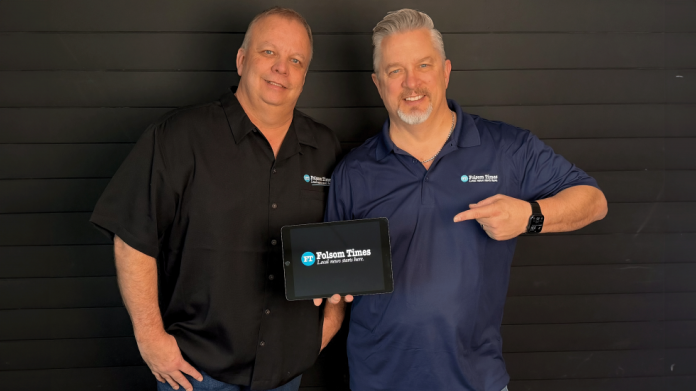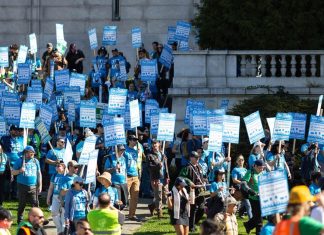Bill Sullivan is a local newsman at a time when local news is
struggling. That’s why, after the Folsom Telegraph publisher was
laid off two years ago, his plan was to go into real estate. “I’m
glad I didn’t go that route,” he says.
Instead, his buddy, tech-entrepreneur Adam Frick, reached out,
and the two launched the Folsom Times the very next
day. Sullivan handles the news-gathering operation, and Frick
manages the website. Together, their digital startup aims to fill
the gaps in local coverage as many community newspapers fade
away.
The Capital Region’s largest title, The Sacramento Bee, has seen
its average daily print circulation decrease by 76 percent over
the past four years, according to an
archived company
webpage and an ownership statement obtained from the
U.S. Postal Service via FOIA request. Circulation was 21,367 in
2024, down from 90,244 in 2010.
And the Bee isn’t alone. A
Pew Research Center report shows print circulation is
declining industry-wide. Any additional money papers make from
digital doesn’t come close to replacing the revenue lost from
print. This deficit led to job cuts. In 2005, papers nationally
employed 75,000 newsroom workers. Sixteen years later that number
was less than half, according to the
Medill School of
Journalism.
Many digital news outlets like the Folsom Times have popped up in
the Capital Region over the past two decades. Are they destined
to cease like the newspapers that came before them, or is it
possible to build a local newsroom financially sustainable enough
to last?
Sullivan says yes. His business is “very profitable” due to low
overhead costs and support from community stakeholders. Sullivan
has the skills and connections needed to write “heartfelt stories
that people really engage in.” The web traffic generated helped
Folsom Times pick up “major premier advertisers” like
entertainment venues, hospitals, credit unions and a local
casino.
Frick was also vital to their success. He designed their website
and created ad placement software and an online business
directory. “Any local news site is going to need a journalist and
a (web) developer. This is the partnership of future news,” Frick
says. His efforts saved money and caused the Folsom Times to
appear higher on Google search results.
Equally important were the two men’s local ties. Sullivan serves
on history and museum boards, and Frick is a rodeo announcer and
auctioneer who plays Santa Claus at public events. “We got the
popularity as quickly as we did because we pumped out news and we
knew everybody,” Frick says. “That was a key for us to get
embedded into the community pretty quickly.”
The Folsom Times makes enough to afford a few private contract ad
salespeople and some freelance writers. The owners want to grow
the business and hire full-time reporters. For the moment it’s a
two-man operation, which makes it twice the size of many digital
newsrooms in greater Sacramento. Its profitability also makes it
an outlier. However, a lack of funds hasn’t deterred other local
journalists from reporting on their communities.
The volunteers
When the local newspapers cut staff or shut down, it was the
bloggers who took the first stab at replacing them. Two decades
ago John Todd launched a community news site for Rio Linda,
citing a lack of day-to-day coverage of his hometown, especially
in high school sports. He had little journalism experience but
used his background in IT to create MyRioLinda.com in 2005, which later
became Rio Linda Online. “Before I
knew it, I had a following,” he says. Still, it isn’t a lucrative
business.
John Todd created Rio Linda Online, formerly MyRioLinda, in 2005.
(Courtesy photo)
Todd makes scant money from online ads and donations. “I’m
generating more revenue now than I ever thought was possible,”
Todd says about Rio Linda Online. However, he has to work as a
self-storage facility manager to pay the bills. That doesn’t
bother Todd. He sees his reporting as an act of community
service. “It’s what I do. It’s part of my identity,” he says, and
a side effect is “there are a lot of people who call me Mr. Rio
Linda.”
Dan Gougherty takes more of a watchdog approach to his reporting
for Elk Grove News.Net, which he started in
2008. He mostly covers mundane government meetings to hold
elected officials in Elk Grove accountable to the public. It’s a
“civic service” he does in semi-retirement. Gougherty had little
reporting experience prior, but possessed the free time and drive
needed to do the job. He’s seen other hyper-local news sites come
and go because “it’s a grind” and “it’s hard to make a living on
this.”
Gougherty makes some money from ads, but he would rather focus on
reporting than try and compete with social media platforms. Both
he and Todd lack succession plans. The future of their websites
will depend on a person stepping up. “It would have to be
somebody who’s really committed,” Gougherty says. Time will tell
if it’s too much of an ask.
The aggregators
Attending public meetings, researching and conducting interviews
is time consuming. So some bloggers take a different approach. In
2008, Danny Luna started WestSacWeb.com as a news
source for West Sacramento. Luna grabs social media posts from
government agencies and articles from newspapers and TV stations
to tease on his website. His posts consist of text snippets with
a source link. He shares this on Facebook to drive web traffic.
Luna’s background isn’t in journalism but in IT. He’s retired,
and what little he earns from selling website ads is spent on
cigars, golfing and vacations. His news aggregator offers readers
convenience and small family-owned establishments a marketing
opportunity. “If you want to promote to West Sac, unless you
have your own social media promotions, there’s really not a lot
out there,” Luna says.
Doc Souza runs another local news aggregator called Elk Grove Laguna News. The
website spawned out of an online forum Souza started in 2010,
with the news site coming about six years later. Souza didn’t
have any formal journalism experience but started the site
because he saw the need for local news and “it was a void that I
could help fill.” The stay-at-home dad’s hobby became a full-time
job after he started selling ads posted to his Facebook page.
Souza doesn’t do original reporting. Instead, he summarizes
articles and social media posts while linking back to them. His
business curates and brings attention to stories from official
sources. However, he doesn’t think news aggregators like his can
replace a traditional newspaper. “Most of the people that are
doing what I do, I don’t think that they have the resources to
actually do an in-depth story,” Souza says. “So we definitely
need both.”
The columnists
Local news sites are typically free, but some community
journalists have found financial success using paywalls to charge
readers for content. Last May, Bob Dunning, a general news
columnist and sportswriter at the Davis Enterprise, was laid off.
He had worked at the newspaper for 54 years and unexpectedly lost
his main source of income. Today he’s doing “substantially
better” with help from subscribers to his Substack newsletter
called The Wary One. Substack writers
can choose either to share their newsletters for free or charge a
monthly subscription, of which the company takes 10 percent.
People pay to read Dunning’s slice-of-life writings and UC Davis
sports coverage. And he’s making more now than he ever did at the
Enterprise. Other Substack writers have asked Dunning for advice,
and he doesn’t know what to say because “my situation was
relatively unique.” Dunning is well-known in Davis, and his
layoff shocked the community. Residents rallied to his aid. “By
golly, the word got out and the subscriptions started rolling
in,” Dunning says. “It was mind-boggling how fast it happened.”
A similar situation happened to business columnist Wendy Weitzel.
She started writing her column Comings & Goings for the
Enterprise in 2001 and cut ties with the paper in protest after
Dunning lost his job. She moved to Substack, which quickly became
her main income source. It’s so successful that she plans to stop
public relations writing.
Like Dunning, Weitzel “got a boatload of subscribers all at
once,” though she says newsletters are typically slow to build
momentum. “I don’t claim to be an expert in this, because we just
got lucky with our timing, and we’ve been building this for so
long,” Weitzel says. Local news writers like Dunning and Weitzel
can make a living off paying subscribers, but they’re not the
norm and succeeded after cultivating an audience for decades.
The nonprofits
Grants and donations are another option for supporting local news
and are the go-to funding source for nonprofits like the Davis Vanguard. The
organization doesn’t have a traditional newsroom or full-time
writers, but trains college students in courtroom reporting and
teaches journalism to prisoners. Founder David Greenwald said
some of the more than 500 Court Watch program participants have
gone on to journalism careers. Many others have enrolled in law
school to become attorneys. The Vanguard originated in 2006 as an
alternative news site written entirely by Greenwald while
studying political science in graduate school. The educational
programs came years later, and the Vanguard became a nonprofit in
2012.
Greenwald produces some local news coverage and takes article
submissions from the community. The nonprofit has eight on its
payroll, most part time, with a “shoestring budget” funded
entirely by donations and grants. Greenwald spends half his time
on fundraising, which can be difficult. But to him, nonprofit
news, ”that’s the wave of the future, and then figuring out how
to fund it is the challenge.” And he isn’t alone in that
thinking.
Open Vallejo is an
experimental investigative and explanatory newsroom. It
originated in 2019 when Geoffrey King, First Amendment lawyer and
college professor, became concerned with his city government and
local police department. His first act as a journalist in Vallejo
was posting “a response to a comment to somebody else’s thread on
NextDoor.com.” The fatal
police shooting of Willie McCoy led King to start “filing just a
gazillion public records requests.” The name Open Vallejo was
used to avoid retaliation. “I decided to do just what felt was
the way I could be most useful to my hometown,” King says.
The nonprofit has published 200 stories, some taking up to a year
to produce, and has a staff of three. King volunteers his time
and two full-time professional journalists are on the payroll,
with 80 percent of funding from grants. “We’re not trying to
replace the local paper, which is still here,” King says. “We’re
just doing the things that were not being published.” Success
will depend on philanthropists.
–
Subscribe to the
Comstock’s newsletter today.








